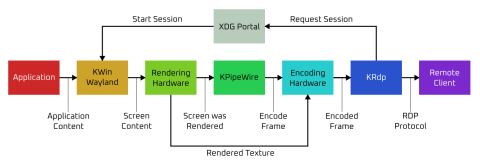With this blog I would like to introduce KRdp, which is a new library implementing
the required glue to create a server exposing a KDE Plasma Wayland session over
the RDP protocol. It also contains a command-line based server
which will allow remote clients to control the current Plasma Wayland session.
Remote Desktop Support for Wayland
With the increase in people working from home the past years and other remote
use cases, it has become increasingly important to be able to control a running
computer remotely. While on X11 there are several existing solutions, for
Wayland the choices are rather more limited. Currently the only way of allowing
remote control of a Plasma Wayland session is through Krfb, which uses VNC1
for streaming to the client.
Unfortunately, VNC is not ideal, for various reasons. So to provide a better
experience we started looking at other options, eventually settling on building
something around the RDP protocol. Fortunately, because of the work done for
Krfb and various other projects, we do have all the parts implemented to allow
remote desktop control, the "only" thing left was to glue everything together.
Why RDP?
This raises the obvious question of "why use RDP?". There were several things
we considered when starting with this. From the start, we knew we wanted to
build upon something pre-existing, as maintaining a protocol takes a lot of
time and effort that are better spent elsewhere within KDE. Especially because
a custom protocol would also mean maintaining the client side. Both VNC and RDP
have many existing clients that can be used, which means we can focus on the
server side instead.
Another major consideration is performance. VNC sends uncompressed images of
the full screen over the wire, which means it requires a lot of bandwidth and
performance suffers accordingly. While I have seen some efforts to change this,
they are not standardised and it is unclear what clients would support those.
RDP, on the other hand, has a documented extension called the "Graphics
Pipeline" that allows using H.264 to compress video, greatly reducing the
needed bandwidth.
The main drawback of RDP is that it is owned by Microsoft and developed for the
needs of Windows. While a potential problem, the protocol is
openly documented and, equally important for us, there is an extensive
open-source implementation of both server and client side of the protocol in
the form of FreeRDP. This means we do not need to bother with the details of
the protocol and can instead focus on the higher level of gluing everything
together.
While I am talking about client support and performance since those were some
of our main considerations, RDP has many more documented extensions that, long
term, would allow us to greatly enhance the remote desktop experience by adding
features such as audio streaming, clipboard integration and file sharing.
Other Considerations
While the protocol was one major thing that needed to be considered for a good
remote desktop experience, it was not the only part. As mentioned, we
technically have all the pieces needed to enable remote desktop, but some of
those pieces needed some additional work to really shine. One example of this
is the video encoding implemented in KPipeWire.
During development of KRdp it became clear that using pure software encoding
was a bottleneck for a responsive remote desktop experience. We tried several
things to improve its performance, but ultimately concluded that we would need
to use hardware encoding for the best experience. This resulted in KPipeWire
now being able to use VA-API for hardware accelerated video encoding, which
not only benefits KRdp but also Spectacle once it is released with KDE Plasma 6.
Another part is the KDE implementation of the FreeDesktop Remote Desktop
portal. While it would be possible to directly communicate with KWin to request
remote input and a video stream, we preferred to use the portal so that it
would be possible to run KRdp from within a sandboxed environment. However, the
current implementation is fairly limited, only allowing you to choose to accept
or reject a remote desktop request. We are working on adding some of the same
features to the remote desktop portal as are already available for the
screencasting portal. This includes screen selection and remembering the
session settings.
KRdp
So all that leads us back to KRdp, which is a library that implements the glue
to tie all these parts together to allow remote desktop using the RDP protocol.
It uses the FreeDesktop Remote Desktop portal interface to request a video
stream and remote input from KWin, uses KPipeWire to encode the video stream
to H.264 and FreeRDP to send that to a remote client and receive input from that
client. The long term goal is to integrate this as a system service into KDE Plasma,
with a fairly simple System Settings page to enable it and set some options.
Trying it Out
For those who want to try it out, we are releasing an alpha as a Flatpak bundle
that can be downloaded from here. This Flatpak, when run using
flatpak run org.kde.krdp -u {username} -p {password} will start a server
and listen for incoming connections from remote hosts. See the readme for more
details and known issues. The Flatpak bundle was built from this code.
If you encounter any other issues, please file them at bugs.kde.org.
Discuss this blog post at discuss.kde.org.
-
While strictly speaking the protocol used by VNC is called Remote
Framebuffer or RFB, VNC is the general term that is used everywhere, so that is
what I am using here as well. ↩

